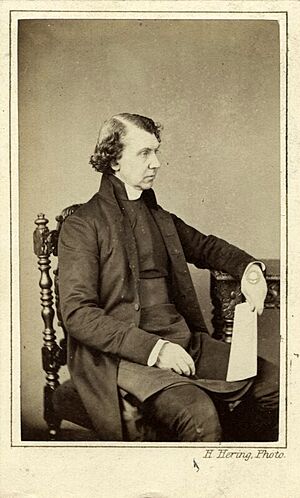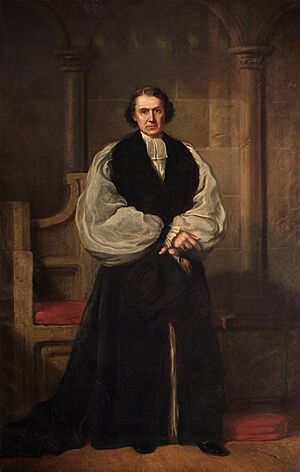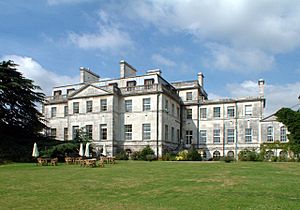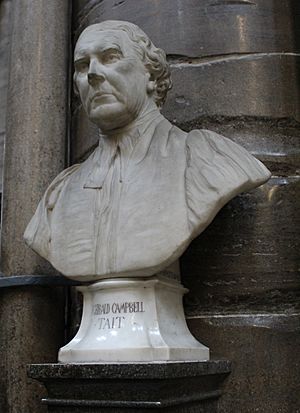Archibald Campbell Tait facts for kids
Quick facts for kids The Most Reverend and Right Honourable Archibald Campbell Tait |
|
|---|---|
| Archbishop of Canterbury | |
 |
|
| Province | Canterbury |
| In Office | 1868–1882 |
| Predecessor | Charles Longley |
| Successor | Edward White Benson |
| Personal details | |
| Born | 21 December 1811 Edinburgh, Edinburghshire, Scotland |
| Died | 3 December 1882 (aged 70) Addington, Surrey, England |
| Buried | Church of St Mary the Blessed Virgin, Addington, London |
| Spouse | Catharine Tait |
| Children | 9 |
| Academic background | |
| Education | University of Glasgow Balliol College, Oxford |
| Academic work | |
| Institutions | Balliol College, Oxford |
| Notable students | Arthur Penrhyn Stanley |
| Main interests | Theology, classics |
Archibald Campbell Tait (born December 21, 1811 – died December 3, 1882) was an important leader in the Church of England. He served as the Archbishop of Canterbury, which is the main leader of the Church of England. He was also a theologian, someone who studies religious beliefs. He was the first person from Scotland to become the Archbishop of Canterbury.
Contents
The Early Life of Archibald Tait
Archibald Tait was born in Edinburgh, Scotland, on December 21, 1811. His father was Crauford Tait, a lawyer, and his mother was Susan Campbell.
He went to school at the High School in Edinburgh and later at the Edinburgh Academy. Even though his parents were Presbyterian (a different Christian group), Archibald became interested in the Scottish Episcopal Church.
In 1830, he started studying at Balliol College at the University of Oxford. He was a very good student, earning top grades in classics (the study of ancient Greek and Roman culture). He became a fellow and tutor at Balliol, meaning he was a teacher there. In 1836, he became a deacon, and in 1838, a priest in the church.
At age 26, he became a senior tutor at Balliol. This experience helped him later when he joined the first Oxford University Commission. He didn't agree with the Oxford Movement, a group that wanted to bring back older church traditions. In 1841, he helped write a famous protest against their ideas.
In 1842, he became the headmaster of Rugby School, a famous school in England. One of his students was Lewis Carroll, who later wrote "Alice in Wonderland." After getting seriously ill in 1848, he became the dean of Carlisle in 1849. This job was less demanding.
While in Carlisle, he worked to restore the cathedral and helped people in the community. He also faced a great sadness there. In 1843, he had married Catharine Spooner. She was a big support to him and helped the poor. But in 1856, five of their nine children died from scarlet fever within just five weeks. This was a very difficult time for them.
Becoming a Church Leader
In 1856, Archibald Tait became the Bishop of London. This was a very important position. Then, in 1868, he was chosen to be the Archbishop of Canterbury. This made him the most senior leader of the Church of England. He had turned down the offer to be the Archbishop of York in 1862.
His last years were also marked by illness and sadness. In 1878, his only son, Craufurd, died. Soon after, his wife, Catharine, also passed away. Five of their eight daughters had also died in childhood, all from scarlet fever in 1856.
Archbishop Tait's Achievements
As a bishop, Tait worked very hard. He was even more active than the previous bishop, Blomfield.
- He started the Bishop of London's Fund in 1863 to help build more churches.
- He spent a lot of time doing evangelistic work, which means spreading the Christian message.
- He cared deeply about helping the clergy (church leaders) in their work.
- With his wife, he helped organize women's work in the church. He also helped set rules for Anglican sisterhoods (groups of religious women).
- He was good at managing and organizing church affairs.
- He regularly attended parliament and worked to pass useful laws. For example, he helped change rules for church members (1865), create a new lectionary (a list of Bible readings for church services) in 1871, and pass the Burials Act in 1880. These changes were sometimes unpopular at the time.
Dealing with New Ideas
Tait was open to new ways of thinking. When it came to questions of faith, he wanted to keep peace and make sure people followed church laws. Sometimes, he would support a new idea, but then he might pull back.
For example, he showed some support for writers of a book called Essays and Reviews. But then he joined other bishops in criticizing it. This made some people think he was changing his mind or couldn't be trusted. However, he was trying to find a balance and keep the church united.
Dealing with Church Traditions
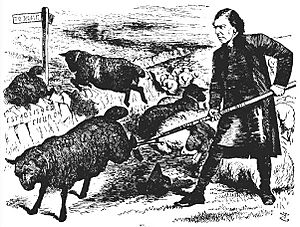
Tait also dealt with the "Catholic revival" in the church, especially about ritualism. This was about how church services were performed, with some wanting to use more traditional ceremonies.
He tried to make sure people followed the rules set by the courts. If they didn't, he tried to get them to obey for the sake of peace in the church. He didn't always understand why some "ritualists" felt so strongly about their practices.
This led to the Public Worship Regulation Act 1874. This law was meant to make sure church services followed certain rules. However, some parts of the law, added by others, caused problems. Clergy members who didn't follow the law could be removed from their positions or even put in prison. This made many people, even those who didn't care much about rituals, very upset.
Archbishop Tait was also upset by these harsh outcomes. He tried to help clergy who were facing punishment. For example, when a priest named A.H. Mackonochie was about to lose his church, Tait helped him move to a different church. This helped to calm the situation. After this, the Public Worship Regulation Act was used less often.
Death and Lasting Impact

Archibald Tait died on December 3, 1882, at Addington, London. He is buried in the churchyard of St Mary the Blessed Virgin in Addington. His grave is marked by a large Celtic cross.
Even though he spent most of his life working in England, he always remained a Scotsman at heart. Some people felt he didn't fully understand the history of the English Church. He was a strong leader who worked hard to achieve his goals. He may not have been a "great" church statesman, but he managed his office well and was an important public figure of his time.
His daughter, Edith Murdoch Tait, married Randall Davidson. Randall Davidson later also became the Archbishop of Canterbury, partly because of Tait's influence.
Memorials
After his death, a stone monument with a bronze bust was put up in Edinburgh, where he was born.
His most important memorial is a white marble bust in Westminster Abbey. It was placed there in 1884.
Addington Palace, where he lived as Archbishop, is now a golf course.
Works
- The Dangers and Safeguards of Modern Theology (1861)
- Harmony of Revelation and the Sciences (1864)
Images for kids


